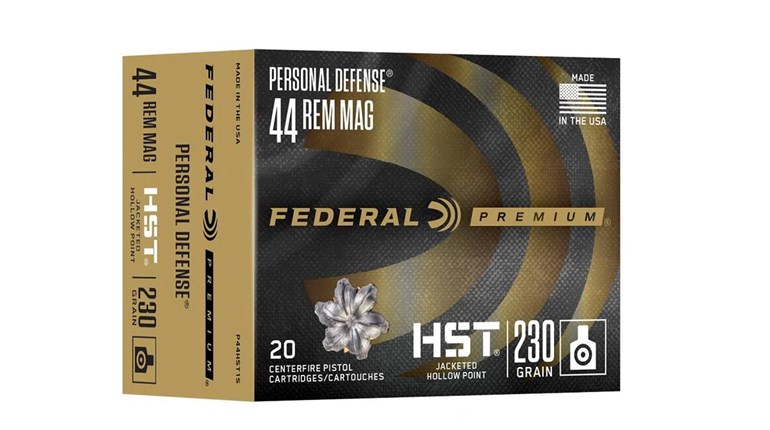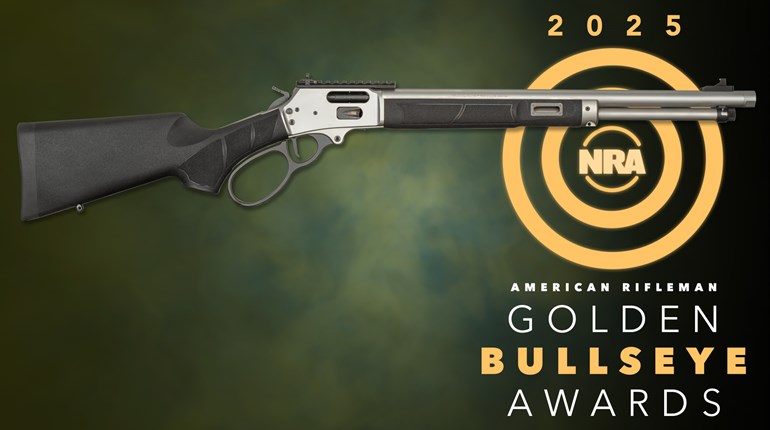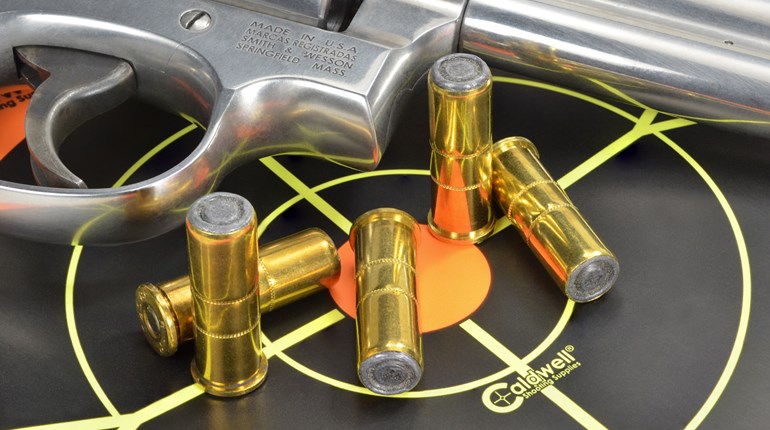
These cartridges all have common names that, when compared to bullet and bore diameters, can be confusing. (Left to right: .380 ACP, 7x57 mm Mauser, .357 Mag., .38 Spl. and .44 Mag.)
Caliber is a critical aspect of ammunition, but it is something that is also often misunderstood or misrepresented. As it relates to firearms, caliber by definition—according to Merriam-Webster—is either A: the diameter of a bullet or other projectile, or B: the diameter of the bore of a gun usually expressed in hundredths or thousandths of an inch and typically written as a decimal, such as .35 caliber.
This all gets rather complicated when you realize the bore of a gun has two diameters. One diameter is measured between the lands and another diameter is measured between the grooves. The groove-to-groove diameter often equals the diameter of the bullet the gun is designed to fire, but sometimes neither diameter translates to the actual given name of the cartridge, which should never be considered an accurate representation of caliber or a measurement of anything.
These bore diameters and given cartridge names are managed by the Sporting Arms and Ammunition Manufacturer’s Institute (SAAMI), which publishes “Voluntary Industry Performance Standards” for the American manufacture of firearms and ammunition. This guide is where manufactures can find the correct groove-to-groove and land-to-land diameter, the correct bullet diameter and the correct full and abbreviated names for all SAAMI-approved cartridges. All this information is available online at saami.org, and a study of these standards will yield some interesting information.
For example, the .38 Spl. cartridge is often regarded as .38 caliber. Revolvers chambered for .38 Spl. have a groove-to-groove bore measurement of .355 inch and a land-to-land bore measurement of .346-inch. To further complicate the issue, bullets for .38 Spl. measure .357 inch in diameter. So, here we have three different critical and specified measurements, none of which have any relationship to the cartridge’s name. This is not uncommon. The .44 Mag. has a groove-to-groove diameter of .429 inch and a land-to-land diameter of .417 inch, and it is designed to fire bullets with a diameter of .4295 inch. Though it is considered to be a .44-caliber cartridge, none of these measurements have anything to do with .44 caliber.
All these important measurements and numbers can be even further complicated. The German-designed 7x57 mm Mauser cartridge fires a bullet measuring .284 inch in diameter and has a groove-to-groove diameter of .283 inch, which equates to 7.213 and 7.188 mm, respectively. But, the barrels of rifles that fire cartridges generally considered to be 7 mm have a land-to-land dimension of .2755 inch, which exactly equals 7 mm. Hence the name of 7x57 mm, which expresses the land-to-land diameter of the barrel (7 mm) and the length of the cartridge case (57 mm). However, in Britain the 7x57 mm Mauser is known as the .275 Rigby.
Where American firearms tend to be known for their groove-to-groove diameter, Europeans tend to use the land-to-land measurement when naming cartridges. For example, the American-designed .308 Win. has a groove-to-groove diameter of .308 inch.
The inconsistencies in cartridge names and actual caliber do not begin and end with the .38 Spl., .44 Mag. and 7x57 mm. The .357 Mag. was aptly named because it uses bullets with a .357-inch diameter, but guns designed to shoot it can also chamber and fire .38 Spl. ammunition. The .38 Super fires a bullet with a diameter of .355 inch, and so does the .380 ACP. Additionally, handgun cartridges generally considered to be .32-caliber actually fire bullets of a .312-inch diameter. I was taught rounding in grade school and .312 is rounded to .31, not .32. Another example of a name not matching caliber is the .460 S&W Mag., which actually fires the same diameter bullet (.452 inch) as the .45 ACP. So, why is it not the .45 or .452 Smith & Wesson Mag.?
If you try to associate caliber to cartridge names, you will get confused, because cartridge names are not representations of caliber. So, why is it that when you read about a cartridge in this and other magazines, the cartridge name is preceded by a decimal point, which would seem to indicate a fractional measurement? With apologies to the editors of this magazine, as well to the editors of just about every firearm periodical currently in print, there is not supposed to be a decimal point preceding a number in any cartridge name, because the numbers in cartridge names are not decimals. [Editor’s note: Think of it as job security for ammo writers.] This is partly because the cartridge name, as we have shown, often has no relation to an actual measurement, regardless of the definition caliber that’s used. And, it’s also partly—and maybe most importantly—because SAAMI says so.
If you take the time to read the Voluntary Industry Performance Standards published by SAAMI, you will find a section titled “Active Cartridges and Chambers” where the SAAMI-approved, full and abbreviated names of cartridges are shown. In the latest SAAMI reference concerning pistol and revolver standards (SAAMI Z299.3 – 2015) these names are found on pages 1 and 2. For centerfire rifle ammunition (SAAMI Z299.4 – 2015), they are found on page 1 through 4. Given their up-front location in these standardization guides, it would seem hard to miss. Ironically, while our firearms and ammunition manufacturers follow SAAMI-measurement guidelines—just look on boxes of ammo—many gunwriters and editors publishing words about them don’t.
It is critically important that you fire a bullet that is of the same caliber/diameter as that of the bore diameter, groove-to-groove, of the firearm you’re shooting. What you cannot do is rely on the given—full or abbreviated—name of the cartridge the rifle, pistol or revolver is chambered for to obtain that information. Caliber and cartridge name are not the same thing. The former is a measurement, and the latter is just a name. So, whatever you do, if you find some .38-caliber bullets, do not try to shoot them in your .38 Spl.






































